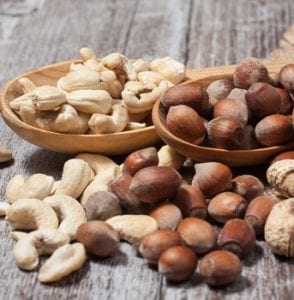Written by Greg Arnold, DC, CSCS. Diabetic Indian participants who supplemented their standard diabetic diet with 30 grams of cashews daily for 12 weeks had a significant increase in HDL cholesterol and a significant decrease in systolic blood pressure compared to the control group.
 Nut consumption has consistently shown to be a benefit to overall health. Specifically, consuming more than 5 servings of nuts per week has been shown to reduce mortality risk by 26% compared to consuming less than 1 serving per month 1. Even consuming 1-3 servings of nuts per month may reduce mortality by as much as 8% 2. Asian Indians have a high lifetime risk of cardiovascular disease and type 2 diabetes 3, which is thought to be due to a diet high in refined grains such as polished rice and refined wheat 4 and low in monounsaturated fats 5 and omega-3 fatty acids 6
Nut consumption has consistently shown to be a benefit to overall health. Specifically, consuming more than 5 servings of nuts per week has been shown to reduce mortality risk by 26% compared to consuming less than 1 serving per month 1. Even consuming 1-3 servings of nuts per month may reduce mortality by as much as 8% 2. Asian Indians have a high lifetime risk of cardiovascular disease and type 2 diabetes 3, which is thought to be due to a diet high in refined grains such as polished rice and refined wheat 4 and low in monounsaturated fats 5 and omega-3 fatty acids 6
In a 2018 study 7, 140 Type 2 diabetic Asian Indians, aged 43-64, were assigned to a control diet, a “standard diabetic diet” defined as “60-65% energy from carbohydrates, 15-25% from fat, and the rest from protein”. The remaining 129 subjects received the same diabetic diet but with 30 grams of cashews added per day. Before and after the 12-week long diet, blood pressure and blood samples were taken from each subject.
After 12 weeks, researchers noted a 3.6% decrease in systolic blood pressure in the cashew group compared to a 1.3% decrease in the placebo group, (p = 0.04). Those in the cashew group had a 4.4% increase in HDL cholesterol compared to a 0.2% increase in the control group (p = 0.01). The researcher also noted the “excellent compliance with the nut consumption” in the cashew group, suggesting this is a very easy diet modification to improve overall health.
When suggesting how cashew nut consumption can benefit health, the researchers pointed to 3 possible mechanisms: the high levels of monounsaturated and polyunsaturated fats in cashew “which may increase their fat-burning effect” 8, that “incomplete mastication of nuts leads to loss of calories in the stool” 9, and that “nuts eaten at breakfast could improve feelings of fullness” in adults 10.
For the researchers, “Supplementation of Indian diets with cashew nuts could help to improve the Asian Indians of dyslipidemia with low HDL concentrations, which is an important cardiovascular risk factor contributing to premature cardiovascular disease in this population.”
Source: Mohan, Viswanathan, Rajagopal Gayathri, Lindsay M. Jaacks, Nagarajan Lakshmipriya, Ranjit Mohan Anjana, Donna Spiegelman, Raman Ganesh Jeevan et al. “Cashew Nut Consumption Increases HDL Cholesterol and Reduces Systolic Blood Pressure in Asian Indians with Type 2 Diabetes: A 12-Week Randomized Controlled Trial.” The Journal of nutrition 148, no. 1 (2018): 63-69.
© 2018 American Society for Nutrition.
Posted February 20, 2018.
References:
- Muntwyler J, Hennekens CH, Manson JE, Buring JE, Gaziano JM. Vitamin supplement use in a low-risk population of US male physicians and subsequent cardiovascular mortality. Archives of internal medicine. 2002;162(13):1472-1476.
- Bao Y, Han J, Hu FB, et al. Association of nut consumption with total and cause-specific mortality. New England Journal of Medicine. 2013;369(21):2001-2011.
- Shah A, Kanaya AM. Diabetes and associated complications in the South Asian population. Current cardiology reports. 2014;16(5):476.
- Radhika G, Sathya RM, Ganesan A, et al. Dietary profile of urban adult population in South India in the context of chronic disease epidemiology (CURES–68). Public health nutrition. 2011;14(4):591-598.
- Lakshmipriya N, Gayathri R, Praseena K, et al. Type of vegetable oils used in cooking and risk of metabolic syndrome among Asian Indians. International journal of food sciences and nutrition. 2013;64(2):131-139.
- Misra A, Sharma R, Gulati S, et al. Consensus dietary guidelines for healthy living and prevention of obesity, the metabolic syndrome, diabetes, and related disorders in Asian Indians. Diabetes technology & therapeutics. 2011;13(6):683-694.
- Mohan V, Gayathri R, Jaacks LM, et al. Cashew Nut Consumption Increases HDL Cholesterol and Reduces Systolic Blood Pressure in Asian Indians with Type 2 Diabetes: A 12-Week Randomized Controlled Trial. The Journal of nutrition. 2018;148(1):63-69.
- Flores-Mateo G, Rojas-Rueda D, Basora J, Ros E, Salas-Salvadó J. Nut intake and adiposity: meta-analysis of clinical trials–. The American journal of clinical nutrition. 2013;97(6):1346-1355.
- Mattes RD, Kris-Etherton PM, Foster GD. Impact of peanuts and tree nuts on body weight and healthy weight loss in adults. The Journal of nutrition. 2008;138(9):1741S-1745S.
- Mori AM, Considine RV, Mattes RD. Acute and second-meal effects of almond form in impaired glucose tolerant adults: a randomized crossover trial. Nutrition & metabolism. 2011;8(1):6.

